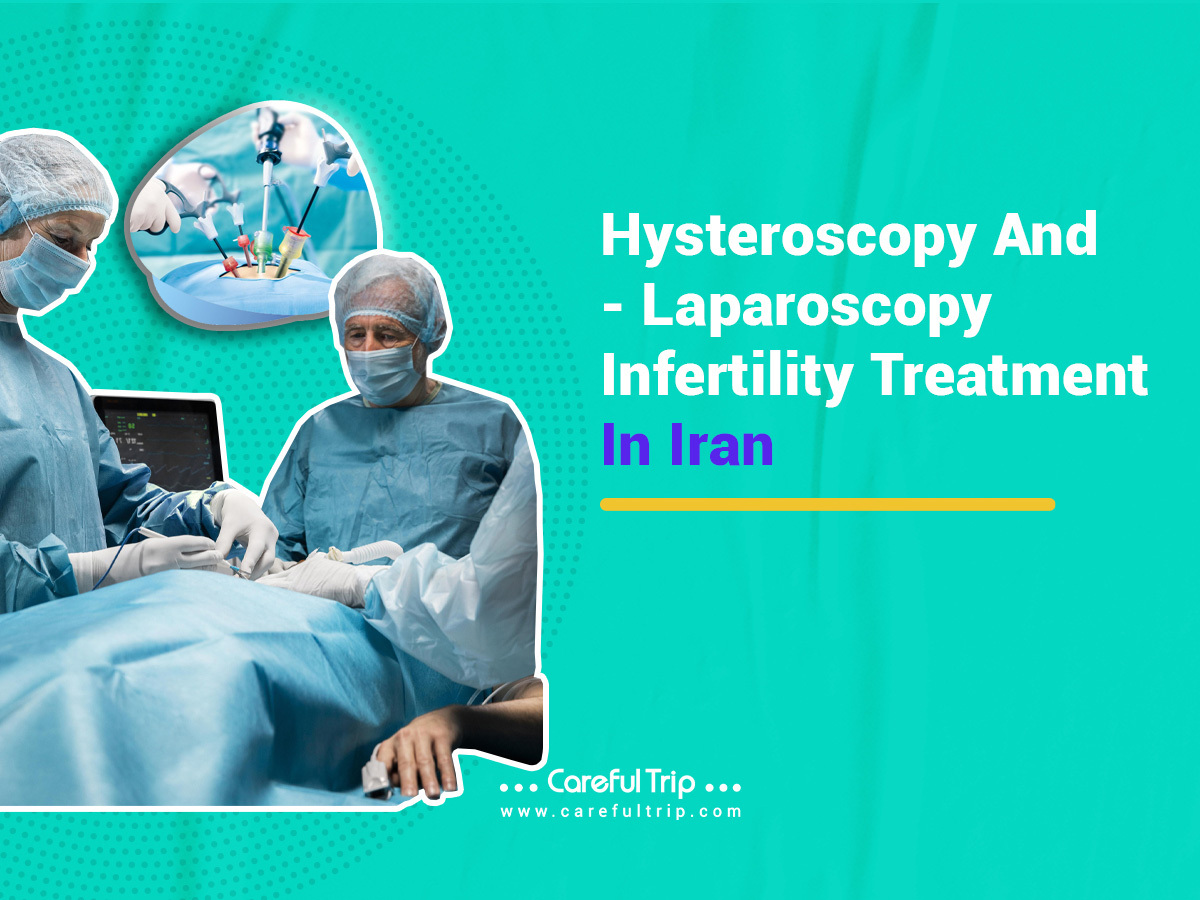
Infertility affects millions of couples worldwide, prompting advancements in reproductive medicine to provide effective solutions. In Iran, two pivotal procedures—hysteroscopy and laparoscopy—play essential roles in diagnosing and treating infertility. These minimally invasive techniques enable surgeons to inspect and address underlying reproductive issues with precision.
Laparoscopy is performed to view and access the exterior of the uterus, ovaries, fallopian tubes, and other structures within the pelvis. Hysteroscopy is performed to view the internal cavity of the uterus, identify abnormalities, and perform specific corrective procedures.
But let us take a closer look at the significance of hysteroscopy and laparoscopy in Iran’s infertility treatment landscape. The article details their procedures, benefits, and potential risks and highlights premier medical centers where these treatments are expertly administered.
For more information, read:
Hysteroscopy And Laparoscopy For Infertility Treatment
Iranian specialists employ a range of diagnostic and therapeutic procedures to address infertility effectively. Hysteroscopy and laparoscopy play pivotal roles, providing critical insights into reproductive health and facilitating targeted treatments to enhance fertility outcomes. Laparoscopy examines different parts of the pelvis, such as the uterus’s surface. At the same time, a hysteroscopy is performed to explore the interior features, such as the uterus cavity, and to check for any anomalies.
What Is Hysteroscopy?
Hysteroscopy is a procedure used to examine the interior of the uterus. It involves using a hysteroscope—a thin, flexible tube equipped with a camera and light—to visualize the uterine cavity. This minimally invasive technique allows doctors to identify and treat abnormalities without requiring extensive surgery.
‘A hysteroscopy can help identify abnormalities within the uterine cavity such as fibroids, polyps, areas of scarring, and congenital malformations. Surgery may be performed during hysteroscopy to correct certain abnormalities. Before surgery, you may be asked to take certain medications to prepare the uterus.’ –Oliver J Brown.
Applications of Hysteroscopy:
- Diagnosing Uterine Abnormalities: Identifying polyps, fibroids, adhesions (Asherman’s syndrome), and congenital uterine anomalies.
- Treating Irregular Uterine Bleeding: Removing fibroids or polyps causing abnormal bleeding.
- Addressing Recurrent Miscarriages: Detecting and correcting structural issues that may impede successful pregnancies.
- Assisting in Assisted Reproductive Technologies (ART): Enhancing the uterine environment for IVF by removing obstructions or abnormalities.
Understanding the specific applications of hysteroscopy helps tailor the treatment to address the underlying causes of infertility effectively.
For more information, Read:
How is Hysteroscopy Conducted?
Preparation:
- Patients may receive preoperative medications to relax the cervix and minimize discomfort.
- Depending on the complexity and patient preference, the procedure can be performed under local or general anesthesia.
Procedure:
- The hysteroscope is gently inserted through the vagina and cervix into the uterus.
- Carbon dioxide, or a sterile fluid, is used to inflate the uterine cavity for better visualization.
- The surgeon examines the uterine lining and can perform necessary interventions, such as removing polyps or fibroids.
Recovery
- The procedure typically takes about 15 to 30 minutes.
- Patients may experience mild cramping or spotting post-procedure, which usually subsides within a few days.
Operative Hysteroscopy: When abnormalities are detected, surgeons may perform operative hysteroscopy to treat them immediately. This may involve removing fibroids, polyps, or adhesions, thereby improving the chances of a successful pregnancy.
Advantages and Disadvantages of Hysteroscopy
Advantages
- Minimally Invasive: Reduces recovery time and minimizes surgical risks compared to open surgery.
- High Diagnostic Accuracy: Provides clear visualization of the uterine cavity, aiding accurate diagnosis.
- Therapeutic Capabilities: Allows for immediate treatment of identified abnormalities during the same procedure.
Disadvantages
- Potential for Infection: Although rare, infections can occur and are typically managed with antibiotics.
- Bleeding: Minor bleeding may occur post-procedure.
- Discomfort: Some patients may experience cramping during and after the procedure.
For more information, Read:
Infertility treatment in Iran for couples from all around the world
What Is Laparoscopy?
Laparoscopy is a surgical procedure used to examine the pelvic and abdominal organs. It involves using a laparoscope—a thin, flexible tube with a camera and light—to visualize the pelvic cavity. This technique is instrumental in diagnosing and treating conditions that contribute to infertility.
Applications of Laparoscopy
- Detecting Endometriosis: Identifying and removing endometrial tissue outside the uterus.
- Assessing Fallopian Tube Health: Checking for blockages or damage in the fallopian tubes.
- Identifying Ovarian Cysts: Diagnosing and treating cysts that may affect fertility.
- Treating Adhesions: Removing scar tissue that can interfere with egg transport.

How is Laparoscopy Conducted?
Preparation
- Patients undergo preoperative evaluations, including blood tests and imaging studies.
- The procedure is performed under general anesthesia.
Procedure
- Small incisions (usually three) are made in the abdominal wall.
- The laparoscope is inserted through one incision, while surgical instruments are introduced through the others.
- Carbon dioxide gas inflates the abdomen, providing a clear view of the pelvic organs.
- The surgeon examines the pelvic cavity and performs necessary interventions, such as removing endometrial lesions or repairing fallopian tubes.
Recovery
- The procedure typically lasts between 30 minutes to two hours.
- Patients may experience mild pain and require a short hospital stay, depending on the extent of the surgery.
Operative Laparoscopy: When abnormalities are detected, surgeons may perform operative laparoscopy to treat them immediately. This may involve removing endometrial lesions, repairing fallopian tubes, or excising ovarian cysts, thereby improving fertility outcomes.
Advantages and Disadvantages of Laparoscopy
Advantages
- Minimally Invasive: Results in less postoperative pain and quicker recovery compared to open surgery.
- Enhanced Visualization: Provides a clear view of pelvic organs, aiding accurate diagnosis and treatment.
- Therapeutic Benefits: Enables simultaneous treatment of detected conditions, improving fertility outcomes.
Disadvantages
- Surgical Risks: Includes potential for infection, bleeding, and injury to internal organs.
- Anesthesia Complications: General anesthesia carries inherent risks.
- Scar Tissue Formation: Although minimized, some patients may develop adhesions post-surgery.
Why Choose Infertility Treatment in Iran?
Iran has emerged as a leading hub for infertility treatment in Asia, attracting international patients due to several compelling factors:
Advanced Medical Facilities:
- Iran boasts state-of-the-art hospitals and clinics equipped with the latest medical technology, ensuring high standards of care.
Expert Medical Professionals:
- The country is home to highly trained surgeons, fertility specialists, and medical staff with diverse international backgrounds, enhancing the quality of treatment.
Affordability:
- Compared to Western countries, healthcare expenses in Iran are significantly lower, making high-quality infertility treatments more accessible.
Comprehensive Support Services:
- Iran offers various support services, including five-star accommodations, excellent transportation options, and recreational facilities, ensuring a comfortable stay for medical tourists.
Cultural and Recreational Attractions:
- Patients can explore Iran’s rich cultural heritage and stunning landscapes, making their medical journey both effective and enjoyable.
These factors collectively position Iran as an attractive destination for individuals and couples seeking infertility treatments, including hysteroscopy and laparoscopy.
Hysteroscopy In Iran
Iran offers numerous reputable medical centers specializing in infertility treatments, including hysteroscopy and laparoscopy. One standout institution is the MOM Infertility Treatment Center in Tehran, known for its advanced technologies and high success rates.
MOM Infertility Treatment Center:
- Comprehensive Care: Offers a full spectrum of fertility treatments, including IVF, ICSI, PGD, and surgical interventions like hysteroscopy and laparoscopy.
- Experienced Specialists: Staffed by highly trained fertility specialists and surgeons with extensive international experience.
- State-of-the-Art Facilities: Equipped with the latest reproductive technologies and diagnostic tools.
- Patient-Centric Approach: Provides personalized treatment plans tailored to each couple’s unique needs.
- Support Services: Offers additional services such as translation, accommodation assistance, and transportation for international patients.
Advantages of Undergoing Infertility Treatment in Iran
Cost-Effectiveness:
- Medical treatments in Iran, including hysteroscopy and laparoscopy, are significantly more affordable compared to Western countries, making advanced infertility treatments accessible to a broader population.
High Success Rates:
- Iranian fertility clinics boast high success rates due to experienced specialists and cutting-edge medical technologies.
Comprehensive Support:
- Medical tourism agencies like CarefulTrip facilitate the entire process for international patients, handling everything from visa applications and travel arrangements to accommodation and local transportation. This comprehensive support ensures a smooth and stress-free experience, allowing couples to focus on their fertility treatments without the logistical burdens of international travel.
Cultural Sensitivity and Support:
- Iranian clinics are known for their culturally sensitive approach, ensuring international patients feel comfortable and supported throughout their treatment journey. Multilingual staff and translation services help bridge language barriers, while the respectful and welcoming environment fosters a positive treatment experience.
Recovery and Aftercare
Proper recovery is crucial for the success of hysteroscopy and laparoscopy. Follow these guidelines to ensure a smooth healing process:
- Rest: Allow your body time to heal by avoiding strenuous activities for a few days post-procedure.
- Medication: Take prescribed medications as directed to manage pain and prevent infections.
- Follow-Up Appointments: Attend all scheduled follow-up visits to monitor your recovery and address any concerns promptly.
- Healthy Lifestyle: To support overall health and fertility, maintain a balanced diet, stay hydrated, and avoid smoking and excessive alcohol consumption.
Additionally, gentle physical activities such as walking can promote circulation and aid recovery. To prevent complications, avoid heavy lifting or intense exercise until cleared by your doctor.

Final Words
Hysteroscopy and laparoscopy are invaluable tools in the diagnosis and treatment of infertility. They offer minimally invasive solutions with high success rates. Iran is a premier destination for these procedures, combining advanced medical technologies, experienced specialists, and affordable healthcare services. Medical centers like the MOM Infertility Treatment Center exemplify Iran’s commitment to providing exceptional reproductive health services, making it an attractive choice for couples seeking to build their families.
For those considering infertility treatment in Iran, partnering with medical tourism facilitators such as CarefulTrip can enhance the experience by providing comprehensive support and ensuring a smooth treatment journey. CarefulTrip offers tailored medical tourism services, handling everything from visa applications to travel arrangements, allowing you to focus on your treatment. The MOM Infertility Treatment Center in Tehran is renowned for its expert specialists, high success rates, and patient-centric approach. It is a top choice for international patients seeking high-quality IVF care at affordable prices.
Embark on your IVF journey with confidence, knowing that you can access expert medical care and dedicated support services to help you achieve your dream of parenthood.
References
- World Health Organization (WHO). “WHO Laboratory Manual for the Examination and Processing of Human Semen.” 5th Edition.
- American Society for Reproductive Medicine (ASRM). “In Vitro Fertilization (IVF).”
- Oliver J. Brown. “Laparoscopy & Hysteroscopy”
- Laparoscopy and Hysteroscopy ‘Laparoscopy and Hysteroscopy’
- Mayo Clinic. “In Vitro Fertilization (IVF).”
- National Institutes of Health (NIH). “In Vitro Fertilization (IVF).”
